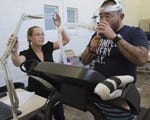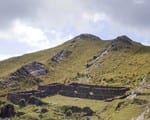The heated energy sources were discovered in the Mountain State by examining previously overlooked oil and gas data.
Reporter Amy Wolff Sorter with Dallas Innovates reported on the research of the SMU Geothermal Lab, which has identified in West Virginia what may be the largest geothermal hot spot in the United States.
The Dallas Innovates article, “SMU Researchers Find West Virginia Geothermal Spots,” published May 26, 2017.
EXCERPT:
By Amy Wolff Sorter
Dallas Innovates
The state of West Virginia has been home to coal-driven energy for nearly two centuries. Now, there could be another energy source directly under the Mountain State’s surface discovered by researchers at Southern Methodist University in Dallas.The researchers, examining previously overlooked oil and gas data, located several hot patches of earth, some as hot as 392 degrees Fahrenheit. These hot patches are situated roughly three miles under the state’s surface. In fact, scientists believe West Virginia could be sitting on the largest geothermal hot spot in the United States.
Geothermal patches overlooked in data
SMU’s Geothermal Lab Coordinator Maria Richards told the Exponent Telegram in Clarksburg, West Virginia that the hot patches were discovered by studying previously overlooked oil and gas data.“We were aware that there were hot springs along the faults in West Virginia, and there was a basic understanding that there could be some sort of higher elevated areas, but we had never had the resources to be able to go back out and look at the deeper data until we had this project from Google that allowed us to bring in the oil and gas data,” she said.
The hot-water reservoirs were once considered too deep for inexpensive production.
However, “because of oil and gas drilling and some of the newer technologies in terms of drilling and pumping, some new innovative ways of developing systems, we can now go into places where we can inject water or a fluid that will then bring out that heat,” Richards said.
Geothermal’s appeal is that it is emission-free. It also has a smaller footprint, as energy is generated from underground wells.
Additionally, this particular renewable energy can overlap with other forms of energy, such as coal.
SMU’s Richards said that hot fluid can be used to dry coal, which, in turn, helps it burn more efficiently. The cleaner the coal burns, the less coal is required to produce electricity.
“Rather than having to burn a fossil fuel to generate electricity to create heat, the goal is to use the heat from the earth to create that heat automatically without having to generate electricity,” Richards said.



 NASA data leads to rare discovery: Earth’s moon wandered off axis billions of years ago
NASA data leads to rare discovery: Earth’s moon wandered off axis billions of years ago Good news! You’re likely burning more calories than you thought
Good news! You’re likely burning more calories than you thought New look at Pizarro’s conquest of Inca reveals foot soldiers were awed by empire’s grandeur
New look at Pizarro’s conquest of Inca reveals foot soldiers were awed by empire’s grandeur Charity, social justice and earth-friendly activism replace big houses, diamond rings and ostentatious living for status seekers
Charity, social justice and earth-friendly activism replace big houses, diamond rings and ostentatious living for status seekers National Center for Arts Research white paper counters findings of the Devos Institute Study on Culturally Specific Arts Organizations
National Center for Arts Research white paper counters findings of the Devos Institute Study on Culturally Specific Arts Organizations 17 million-year-old whale fossil provides 1st exact date for East Africa’s puzzling uplift
17 million-year-old whale fossil provides 1st exact date for East Africa’s puzzling uplift SMU analysis of recent North Texas earthquake sequence reveals geologic fault, epicenters in Irving and West Dallas
SMU analysis of recent North Texas earthquake sequence reveals geologic fault, epicenters in Irving and West Dallas Bitcoin scams steal at least $11 million in virtual deposits from unsuspecting customers
Bitcoin scams steal at least $11 million in virtual deposits from unsuspecting customers Teen girls report less sexual victimization after virtual reality assertiveness training
Teen girls report less sexual victimization after virtual reality assertiveness training Women who are told men desire women with larger bodies are happier with their weight
Women who are told men desire women with larger bodies are happier with their weight Fossil supervolcano in Italian Alps may answer deep mysteries around active supervolcanoes
Fossil supervolcano in Italian Alps may answer deep mysteries around active supervolcanoes